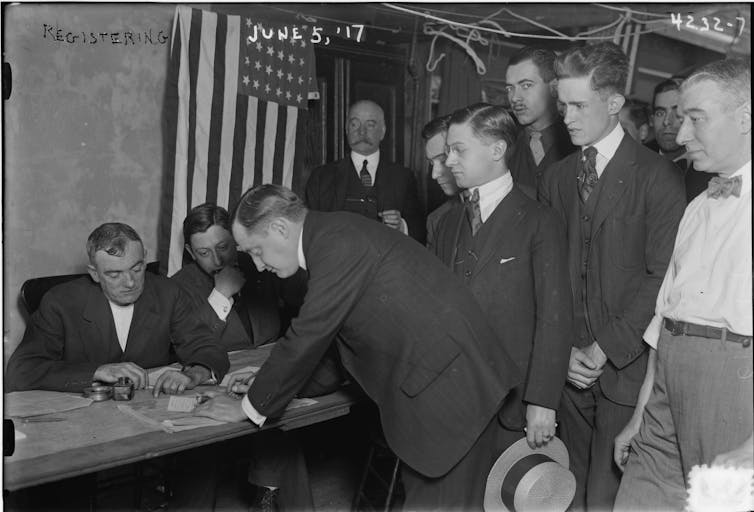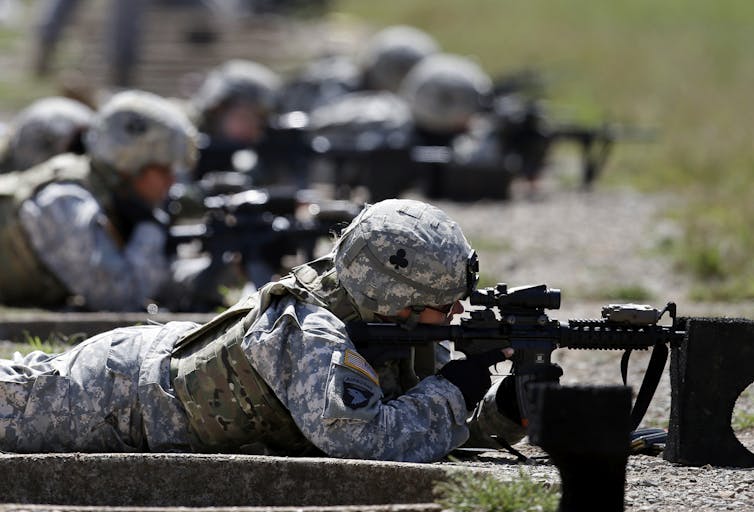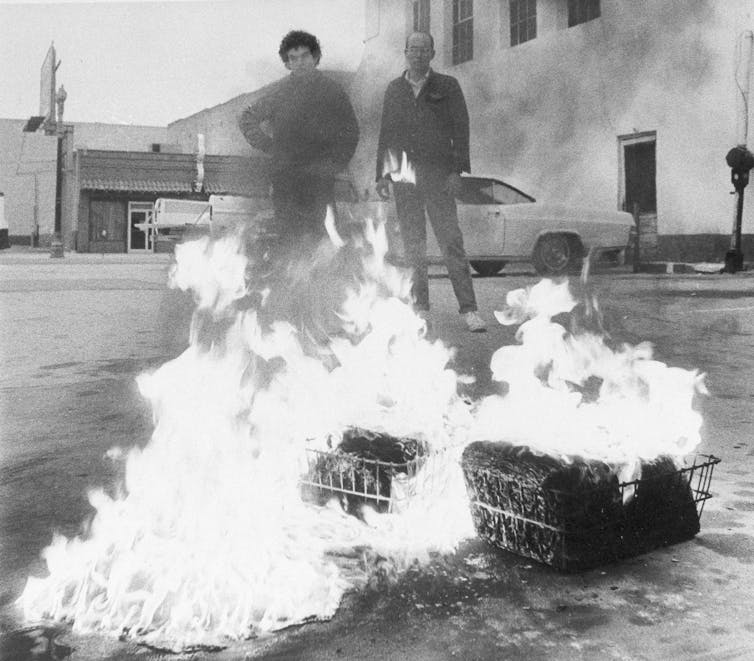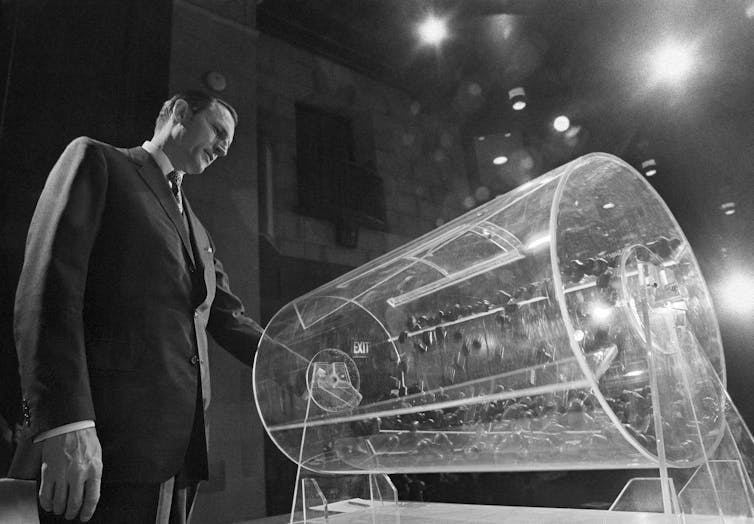Will We Have a Draft Again
The Supreme Court has declined to hear arguments in the case of National Coalition for Men v. Selective Service System. In doing and so, it acceded to the Biden administration's wishes that it not address the question of whether women should join the millions of young men required to annals each yr with the Selective Service – the federal agency responsible for the typhoon. It volition now exist upward to Congress to decide what, if anything, to do with the law governing registration and the draft.
Equally scholars of the draft, we have seen Congress grappling with the question of selective service for years. A bill to include women in the draft was introduced in 2020 after a national committee studied the event for four years. Congress is as well because two other proposals to dismantle the entire Selective Service Organisation.
The future of the draft, and registration for it, depends on two questions. One is near the part of women, but the bigger 1 is near the role of the registration itself.

A cursory history of registration
Registration and the typhoon are non the same thing, although they are related. Registration is the process past which people identify themselves to the government as potentially eligible to be drafted to serve in the military.
In the U.Southward., Congress and the president must pass a police authorizing a draft, at which betoken the government agency known equally the Selective Service System oversees the authoritative procedure of conscription. There has not been a typhoon in the U.South. since 1973, when Congress immune the existing draft authorization, conscripting men into service in the Vietnam War, to elapse.
Two years later, President Gerald Ford suspended men'due south responsibility to register for the draft. Only in 1980, later on the Soviet invasion of Afghanistan, President Jimmy Carter reversed Ford's position, reinstating registration – though non the draft itself. Since so, all male permanent residents of the United States, both denizen and noncitizen, between the ages of eighteen and 26, take been required to register and update their data with the Selective Service every time they move.
Women, who have served in every U.S. state of war, and legally in all combat roles since 2016, have remained exempt from this requirement; they may non even voluntarily register.

It's non really well-nigh women
Politicians and activists are rehashing the same decades-onetime arguments about gender stereotypes and traditional gender roles.
But women serve honorably and finer in every armed services role and branch of service. The rationale used by the Supreme Court in 1981 to exclude them became moot as soon as all available positions, including gainsay positions, opened to women in 2016.
If registration continues, and if there ever once again is a typhoon in the U.S., nosotros and many others believe that women clearly deserve to share equally in the responsibility to serve and the opportunity to earn the benefits of armed forces service.
So the real question is nearly how draft registration serves society, or doesn't.
Mind the civil-military gap
Ane common belief is that maintaining draft registration bolsters the link betwixt civilians and soldiers, which has weakened significantly since the U.S. military became an all-volunteer force. Through the last two decades of war, only 1% of Americans have served in the military machine.
Some experts propose that such a weak noncombatant-military connexion contributes to a number of issues, including a lack of familiarity with the military, a military that is not representative of society and an unfair distribution of the human costs of war.
But the Selective Service System is non designed to address those issues. Near registrants practise not requite much thought to the ramifications of checking the box when they renew their drivers' licenses or register to vote. In early 2020 a viral misinformation campaign near an imminent draft led a flood of worried information-seekers to crash the Selective Service's website.
And usually, as the 2020 national report noted, the mere act of registration without whatsoever real chance of being drafted does not profoundly affect people'due south lives.

A force for social change?
Bear witness shows that registration shapes guild simply when it is accompanied past a typhoon – though not always in ways that national leaders might hope. During the Common cold War draft, men factored military service into their life choices by marrying, having children, going to college or choosing professions that offered them legal deferments from the draft.
That, in turn, introduced inequities into the typhoon, undermining the legitimacy of the process. Men with means, especially white men, were significantly more likely to obtain a deferment than working-class men, peculiarly men of color.
The government seems to accept learned from that feel. If the typhoon ever were renewed, these types of deferments would likely not be allowed.
But many more Americans reach draft-eligible age each twelvemonth than the armed forces could peradventure use. Any new draft would withal heighten new questions nigh the fairness of who serves and who does not.
A mobilization machinery?
Without the draft, registration on its ain has been likened to an "insurance policy" against whatsoever time to come threat. Any major conflict with a great ability adversary – however unlikely – would require a much larger armed services than the country has at present.
Registration is supposed to provide Selective Service with a listing of everyone eligible to be drafted and their contact information. So registration theoretically speeds upwards the process of bringing hundreds of thousands of soldiers into the armed services. And planning is important. Failure to program adequately for bringing large numbers of recruits into the armed services has made wartime mobilization complicated in the by, as in the U.K. at the start of Globe War I.

But it's non clear that registration as currently organized would work this fashion. Historically, relatively few people continue their addresses upwards to appointment, and the agency is more focused on getting men to register – not on what happens after they're on the list.
The mobilization process itself is a massive production. During World War II, more than 183,000 volunteers helped evaluate men at over 11,000 local draft and appeal boards. Every person was examined; classified as available, deferred or exempt; and and then processed through the system appropriately, including considering appeals.
In 1967, during the Vietnam War, with a much smaller typhoon than in Earth War II, more than than 31,000 people staffed thousands of local and entreatment boards effectually the nation. The present organisation has just 11,000 volunteers identified every bit set up to assistance.
With no real mode to immediately conduct a draft, it's not clear that registration serves any purpose. For one thing, 97% of registrations are handled electronically, and much of the information duplicates data already stored in other authorities databases, including driver's license records.
In rejecting National Coalition for Men v. Selective Service, the Supreme Court has fabricated it clear that Congress needs to act. Simply as information technology does and so, policymakers demand to evaluate whether the constabulary is able to meet its objectives. If policymakers have other goals, like improving social equity or better linking civilian life with those who serve in the military, mayhap something less abstruse and less bureaucratic – and less expensive – might serve the nation better than simply adding women to the existing legislation.
[You're smart and curious about the world. Then are The Conversation'southward authors and editors. You can read us daily by subscribing to our newsletter.]
vallewhalmoselity.blogspot.com
Source: https://theconversation.com/congress-considers-future-of-the-military-draft-while-supreme-court-holds-off-161152
0 Response to "Will We Have a Draft Again"
Post a Comment